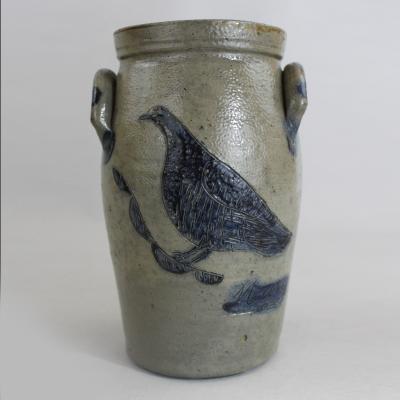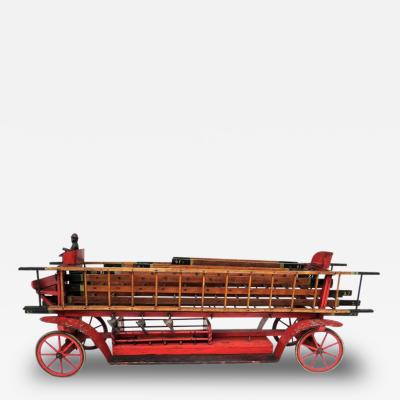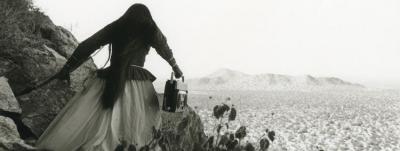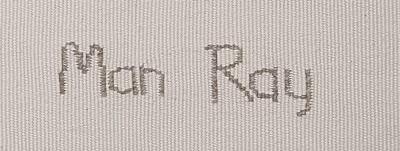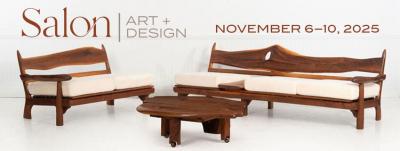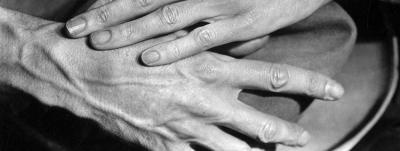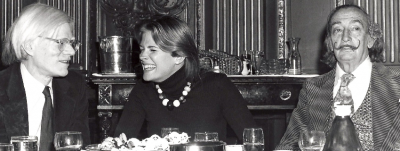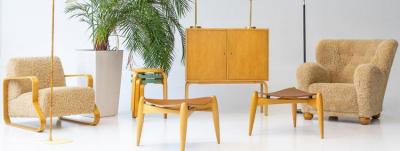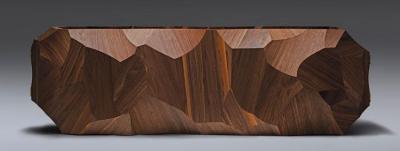The Folk Art Collection of Elie and Viola Nadelman
Elie Nadelman is widely recognized for his spare modernist sculpture, but an exhibition at the New-York Historical Society reveals that he was also a trailblazing collector of folk art. Together with his wife, Viola Spiess Flannery, Nadelman assembled the first significant collection of American and European folk art, which eventually comprised some fifteen thousand objects. The dashing couple’s collecting enterprise began soon after their marriage in 1919 and gathered steam during the heady decade of the 1920s. The Nadelmans were among the earliest American collectors to use the term “folk art” for works created by artisans or self-taught artists that featured simple forms and bold colors, and reflected an “authentic” spirit. Like a number of other American modernists, Nadelman found inspiration for his own sculpture in the simplicity and directness of folk art.
In 1926, the Nadelmans opened an innovative museum on the grounds of their country estate in Riverdale, New York. The Museum of Folk and Peasant Arts was the first folk art museum in the United States and the first in the world to demonstrate the European origins of American folk art. Sharing an all-consuming passion for collecting, both Nadelmans played a critical role in creating their museum: Elie as creative mastermind and Viola as managerial powerhouse. The four-story stone museum commissioned by the couple featured fourteen galleries displaying folk art spanning six centuries and thirteen countries. The Nadelmans installed the galleries by media, to compare related objects from different countries and to highlight their aesthetic qualities.
After suffering financial reversals with the stock market crash of 1929 and the subsequent Great Depression, the Nadelmans struggled to maintain their museum. In 1935 they received support from the Carnegie Corporation, enabling the museum—rechristened the Museum of Folk Arts—to maintain regular hours and welcome more visitors, including school groups. An advisory committee of cultural leaders, among them Museum of Modern Art director Alfred H. Barr Jr., helped professionalize the museum. Despite its resurgence, continued financial difficulties forced the Nadelmans to part with their cherished collection. After selling a small number of works to private collectors, they sold the bulk of their trove to the New-York Historical Society in 1937.
The images that follow are highlights from more than two hundred engaging objects featured in the New-York Historical Society’s exhibition The Folk Art Collection of Elie and Viola Nadelman, the first in-depth examination of the couple’s groundbreaking endeavor, on view from May 20 to August 21, 2016. The exhibition catalogue, Making It Modern: The Folk Art Collection of Elie and Viola Nadelman, is published by D Giles Limited, London. For information visit www.nyhistory.org or call 212.873.3400.

- Elie Nadelman (1882–1946), Tango, ca. 1920–1924. Painted and gessoed cherry wood, 36 × 25-5/8 × 13⅞ inches. Whitney Museum of American Art, New York; Purchase, with funds from the Mr. and Mrs. Arthur G. Altschul Purchase Fund, the Joan and Lester Avnet Purchase Fund, the Edgar William and Bernice Chrysler Garbisch Purchase Fund, the Mrs. Robert C. Graham Purchase Fund in honor of John I.H. Baur, the Mrs. Percy Uris Purchase Fund, and the Henry Schnakenberg Purchase Fund in honor of Juliana Force (88.1a-c). © Estate of Elie Nadelman.
While in Munich and Paris, Nadelman produced art that responded to the modernist ideas he encountered there. After emigrating to the United States in 1914, he created plaster figures in contemporary dress reflecting the popular culture of his adopted country’s more democratic society—dancers, musicians, and circus performers—in a sleek, simple style. Nadelman’s vernacular subjects paralleled his burgeoning enthusiasm for folk art. In Tango Nadelman used stained cherry, his favorite wood, painting only the hands, faces, and the man’s shirt. The slim, elongated pair dance the tango, a risqué Argentine dance that became popular just before World War I in the United States. His composition emphasizes the stylized elegance of the dance rather than its sensuality. The artist avoided the most recognizable step and selected a moment when the dancers separate. Although the sculpture was based on a plaster maquette that Nadelman exhibited at M. Knoedler Gallery in 1919, its composition was probably roughed out by a contract woodcarver and then finished by the artist, as recorded in the Nadelman Papers.
An icon of American folk art, this monumental carved figure celebrates chief engineer Harry Howard, one of the most famous figures in New York City’s firefighting history. The strapping wooden fire chief once crowned the three-story headquarters of the Harry Howard Hose Company No. 55 at 115 Christopher Street, named in his honor. At nearly nine feet tall and in dramatic command, Howard brandishes a speaking trumpet and gestures to his company to lead them into action. In 1936, the Nadelmans discovered the forgotten hero in the cockloft of a Paterson, New Jersey, firehouse and purchased the carving for their Museum of Folk and Peasant Arts. Elie performed restoration work on the figure before installing it in the entry gallery of the museum.
Milliners used life-size heads like these to fabricate, trim, and display hats in their shops or windows. The two unusual wooden examples relate to featureless hat forms for fabricating men’s headgear, while the papier-mâché head has a rectangular opening in the back of its base for ribbons, pins, and millinery tools. It is no wonder that as a long-time textile and lace collector Viola Nadelman was interested in these accoutrements of the trade. The simplified, abstract forms of all three, as well as the bright colors of the papier-mâché example, attracted Elie Nadelman, whose wood sculptures share some of the same formal characteristics. Giorgio de Chirico, whose Parisian stay overlapped that of Nadelman, employed similar mannequins in his paintings. The majority of extant milliner’s heads date from the first three quarters of the nineteenth century, the heyday of the bonnet. The Nadelmans displayed at least one in the “Bonnet room” of their Museum of Folk and Peasant Arts.
In 1924 the couple paid the high price of $100 for this rare, unusually large bust. Chalkware, often called the poor man’s Staffordshire, first appeared in Europe in the early 1700s, and was later advertised in New York and Boston newspapers as locally made, usually by Italian immigrants, and sold by itinerant vendors. For the urbanizing middle class, the brightly painted decorative household ornaments were an affordable alternative to figurines in pottery and porcelain. Made of plaster of Paris, they were cast in molds and individually hand-colored to compensate for a lack of modeling. Collectors purchased them with enthusiasm during the 1920s under the misconception that they were made by Pennsylvania Germans. The most popular figures were roosters and domesticated animals, which the Nadelmans purchased together with ornamental pieces such as urns, vases, and miniature churches. The couple recorded over one hundred chalkware pieces in their curatorial cards.
Although Stock was paralyzed below the waist at age eleven, he maintained a successful career as a portraitist in New England during the 1840s and 1850s. His portrayal of Willard Sears of New Bedford, Massachusetts, derives from the tradition of equestrian portraits, and its drapery from formal portraiture. Young Sears holds the reins of his wooden pull-toy horse to embody the wishful thinking of the sitter’s parents that “it becometh a prince best of any man to be a fair and good horseman.” Indeed, Sears became a prominent architect, designing among other buildings, Fenway Court in Boston, the home of Isabella Stewart Gardner (later the Gardner Museum). With the purchase of this portrait in 1921, the couple entered the vanguard of the growing taste for folk art. Nearly two decades later Stock became one of the first widely collected folk portraitists. He is also one of the most documented through advertisements, an inventory, and his seventy-three-page journal.

- Salomon Mayer (active 1792–1811) for the Pseudo-Otto Artist (active ca. 1773–1809). Birth and baptism certificate of Catharina König, York, Pa., 1807. Hand-colored woodcut with handwork in watercolor and black and red ink, 13-1/4 x 16-1/8 inches, irregular. New-York Historical Society; Purchased from Elie Nadelman. Photography by Glenn Castellano.
The term “fraktur” describes the illuminated works treasured as keepsakes and status symbols by Pennsylvania Germans. Fraktur evolved from old German laws that required certificates of birth, baptism, and marriage to be registered with the state. The Nadelmans appreciated their cultural significance, as well as their bright colors and bold designs that relate to other objects produced by Pennsylvania Germans. During the 1740s members of the Ephrata Cloister in Lancaster County produced some of the earliest hand-drawn American fraktur, most drawn and inscribed by ministers or schoolmasters. Responding to an increased demand, printed fraktur, which professional scriveners and decorators enhanced and personalized, became increasingly important after 1780. Mayer, who worked at the Ephrata Cloister, printed this example and the Pseudo-Otto Artist probably added the personal details and embellishments. The Nadelmans acquired both hand-drawn and printed fraktur.
This decorated stoneware vessel was one of the Nadelmans’ most prized objects. In 1931 Elie Nadelman explained its importance to fellow Americana collector Henry Francis du Pont: “It is not only the outstanding piece of early New York pottery, but it is the only magnificent work of the early New York potters which is signed and dated . . . [Crolius was] the most famous of the New York potters . . . This piece . . . is a constant delight.” The profusely and exuberantly ornamented pitcher is incised “New York Feby 17th 1798,” “Blue,” and “Flowered by Mr. Clarkson Crolius.” Although numerous pieces of Crolius stoneware bear the stamp of the pottery, this is the only vessel known with Clarkson’s signature. The Nadelmans had a particular fondness for American stoneware: the Crolius pitcher was exhibited in their museum along with at least one hundred and thirty other examples.
Pennsylvania German pottery held pride of place among the pottery displayed in the Museum of Folk and Peasant Arts, which presented a diverse array of European and American ceramics from the sixteenth through the nineteenth centuries. Troxel’s bold design is characteristically rich with a mélange of Pennsylvania German motifs, patriotic imagery, and political language. The entertaining, if irreverent, verse inscribed around the edge translates loosely as “Our maidservant the sow, who would gladly be a lady any day.” The Nadelmans purchased the dish from New York dealer Matthew Holden in 1926 for the princely sum of $200. They were undoubtedly aware of Edwin AtLee Barber’s 1903 publication on Pennsylvania German “tulip ware,” which referenced this piece.
Two galleries of the Museum of Folk and Peasant Arts dedicated to metals were filled to bursting with ironwork: cast, wrought, and sheet iron spanning seven centuries and made for a multitude of purposes. This wrought iron trammel, purchased by the Nadelmans during a trip to France in 1926, was one of many examples of European and American domestic ironwork on display. Suspended from a horizontal lug pole high in the chimney, trammels provided a hook for hanging a cooking pot and a mechanism for adjusting its height above the fire. This sawtooth-type trammel is a tour de force of blacksmithing, combining a precisely forged ratchet catch mechanism with bold, sinuous ornament. An inverted heart cutout at the center of the blade echoes the forged heart crowning the top.
These colorful wooden flasks held whetstones, finely grained stones used to sharpen tools. Reapers filled them with water to keep the stones moist, strapped them onto their belts, and carried them into the fields. Their abstract painted designs harmonize with the modernist aesthetic characteristic of Elie Nadelman’s own sculpture, as well as paintings of the modernist Robert Delaunay, founder of Orphism, who worked in Paris during Nadelman’s residence. In their form, function, and decoration, this pair embodies the “peasant” in the name of the Nadelmans’ Museum of Folk and Peasant Arts. The museum’s inventory lists nine examples. Found throughout northern Europe, the oblong shapes of this pair—with flat backs, carved ornamentation, and painted motifs—are characteristic of the Swiss type.
George W. Brown, the designer of the magnificent toy riverboat Excelsior, began his career as a clockmaker and added toys to his repertoire in 1856. In 1869 the Connecticut native partnered with J. & E. Stevens to form the Cromwell firm of Stevens & Brown, which offered a complete line of mechanical and nonmechanical tin and iron toys that successfully competed with European imports. Brown’s surviving pattern book includes a watercolor sketch of the Excelsior showing every stamped, stenciled, and freehand painted detail. The toy, perhaps too elaborate to be commercially viable, was never put into general production. The Nadelman Excelsior is one of only two examples known to have been produced.
Roberta J.M. Olson is curator of drawings and Margaret K. Hofer is vice president and museum director, New-York Historical Society.
This article was originally published in the Summer 2016 issue of Antiques & Fine Art, a digitized version of which is available on afamag.com. AFA is affiliated with Incollect.




























